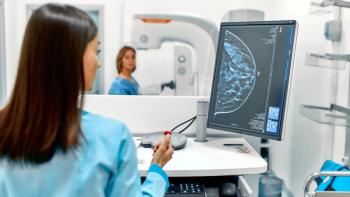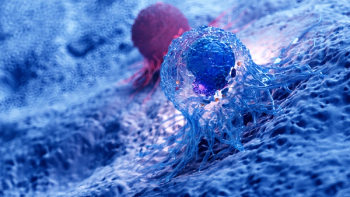
IHC May Sub as NGS for Early TP53-Mutant MDS/AML Detection
An observational study found IHC may serve as a biomarker for early detection of TP53‐mutant MDS or AML and prediction of TP53 allelic state.
Immunohistochemistry (IHC) may serve as a biomarker for early detection of TP53 mutations and prediction of TP53 allelic state in patients with myelodysplastic neoplasms (MDS) and acute myeloid leukemia (AML), according to findings from an observational trial (NCT01174615) published in Cancer.
Findings demonstrated that among evaluable samples (n = 145), the mean percentage of cells with positive staining was 28% (±3.67%) for AML samples compared with 8.8% (±1.61%) for MDS samples (P < .001). Within the MDS subset, the mean percentage of cells with positive p53 staining was 10.7% (±1.96%) for multihit TP53 mutations vs 1.44% (± 0.49%) for monoallelic TP53 mutations (P = .010). These respective rates were 29.6% (± 3.67%) and 0% (± 0%) in the AML subset (P = .034).
When assessing the correlation between IHC and next-generation sequencing (NGS), the specificity was 96.3% for the whole cohort, 95.5% for MDS samples, and 100% for AML samples. IHC sensitivity was 76.3% for the whole cohort. Notably, investigators reported a correlation between IHC positivity and TP53 variant allele frequency (VAF; R2 = 0.228).
“The large‐scale implications for the use of IHC as a surrogate for NGS are apparent when considering that IHC testing is a more cost‐effective measure, and is more readily available than NGS,” lead study author Shyam A. Patel MD, PhD, and colleagues wrote. “This would suggest that IHC is an attractive alternative, especially across global markets and in geographic regions marked by health care inequities as a result of the inability to access genomic testing.”
Patel is an associate professor at the University of Massachusetts Chan Medical School and a hematologist and oncologist at the UMass Memorial Medical Center in Worcester.
Addressing the Gaps of NGS
MDS and AML harboring TP53 mutations are associated with worse prognosis vs other subsets within these malignancies. However, Patel et al explained that current International Consensus Classification (ICC) criteria require NGS testing to confirm the presence of somatic TP53 mutations with a VAF of more than 10%. NGS can be associated with longer turn-around times. Although treatment paradigms for patients with TP53-mutant AML and MDS have not been established, mutational information is valuable in driving treatment selections for these patients, particularly those who are older or frail.
To assess the viability of p53 IHC as a biomarker for TP53 mutations in AML and MDS, investigators retrospectively identified patients with MDS or AML harboring TP53 disruption who were diagnosed between 2014 and 2025. Patients were required to meeting ICC diagnostic criteria for MDS, MDS/AML, or AML with TP53 mutations. The study also included 7 healthy patients without myeloid neoplasms, who served as negative controls, plus 20 patients with MDS without TP53 mutations and 20 patients with AML without TP53 mutations.
IHC testing comprised staining for p53 in blasts, and the observing hematopathologist had no knowledge of TP53 VAF prior to IHC scoring. A positive IHC test was deemed any with a staining of more than 1%. Using NGS results, patients were stratified by multihit status and by TP53 VAF. Multihit status was defined per 2022 ICC criteria.
For an overall survival (OS) analysis, patients were stratified by positivity of p53 IHC staining on bone marrow specimens per hematopathologist assessment. Investigators utilized the Kaplan–Meier method to construct OS curves and confidence intervals.
In the TP53-mutated MDS cohort (n = 42) and AML cohort (n = 40), the median age was 75.3 years (range, 41.6-91.7) and 69.8 years (range, 47.8-82.5), respectively. Most patients in both groups were male (MDS, 64.3%; AML, 70%) and non-Hispanic White (92.9%; 85%, respectively).
Addressing False-Negative Tests
Patel and colleagues noted that in some cases, p53 IHC staining produced negative results despite a positive NGS result. To further dissect these discrepancies, investigators stratified patients by disease subtypes to determine whether IHC testing correlated with mutational testing based on qualifying morphologic features, such as dysplasia or blast enumeration. A positive correlation was observed in 89 MDS bone marrow specimens; a positive but lower correlation was seen among 56 AML bone marrow specimens.
To further assess the correlation between IHC results and TP53 mutational status, patients were stratified into categories based on ICC-defined multihit status—defined by the presence of 2 or more TP53 mutations with a VAF of at least 10%; or a single TP53 mutation with deletion of the TP53 locus at 17p13.1, a VAF above 50%, copy‐neutral loss of heterozygosity at the TP53 locus, or any complex karyotype. Investigators again found positive correlations for MDS with a monoallelic hit and multihit TP53 mutations. A weaker but still positive correlation was noted for AML with multihit TP53 mutations Correlation could not be assessed for AML with monoallelic TP53 mutations, as only 3 patients fell into this subset.
“A p53 IHC threshold of 7% conferred 100% positive predictive value for multihit TP53 [mutations] in MDS and AML,” study authors wrote. “The area under the precision‐recall curve was 0.958 [95% CI, 0.930-0.979].”
In the 28 false-negative tests reported during the study, these samples had a high variability in the TP53 VAFs, with a mean VAF of 27.9% (SD, 26.7%). Additionally, 75% of false-negatives were in patients with multihit TP53, and 25% were in patients with monoallelic mutations. Investigators further assessed the role of specific TP53 codons, TP53 functional domain, and/or the type of aberration correlated with false-negative results.
In 145 bone marrow samples, 64.8% harbored a single missense mutation; sole nonsense mutations, frameshift mutations, 17p deletions, or isochromosome 17 were detected in 8 samples. Notably, all sole nonsense or frameshift mutations led to false negatives by p53 IHC testing when these TP53 mutations were detected via NGS.
In samples with at least 2 TP53 mutations, IHC positivity was reported only in cases with at least 1 missense mutation. Notably, 14.3% of missense mutations led to false-negative results, but 85.7% of missense mutations were detected via IHC. “This suggests that an initial report of negative IHC may not preclude the eventual identification of a nonsense or frameshift mutation,” the study authors explained. “Likewise, a positive IHC result would suggest the eventual identification of a missense mutation.”
OS Outcomes
To analyze OS outcomes, investigators excluded patients who were alive with less than 1 year of follow‐up, and then again for those alive with less than 2 years of follow‐up. In the total cohort, the median OS was 6.95 months.
Findings showed that the median OS was 9.11 for patients with a p53 IHC staining of less than 20% vs 3.83 months for those with a staining above 20% (P = .0071). For patients with staining of less than 40%, the median OS was 9.35 months vs 2.53 months for those with a staining above 40% (P < .001).
Using the 7% threshold for multihit TP53 status, the median OS was 14.63 months for those with p53 IHC staining below 7% compared with 4.50 months for those with staining above 7% (P < .001).
Study Limitations and Next Steps
Patel et al explained that this study featured a relatively small sample size, which could limit the power of the analysis. “Multi‐institutional collaboration would be highly beneficial to more definitively establish a correlation between p53 IHC and TP53 NGS results,” they wrote. “With such collaborations, it would be important to establish cross‐institutional standards with respect to anti‐p53 antibodies, staining methodologies, and sequencing platforms.”
They also noted that the possibility of a false‐negative IHC results for patients harboring TP53 mutations that prevent protein expression may have been another limitation. A final limitation was the use of the ICC definition for TP53 mutations vs the World Health Organization definition, which contains slightly different criteria to define TP53‐mutant MDS with biallelic TP53 inactivation.
“The ability to detect biallelic TP53 mutation in a timely and cost‐effective manner remains clinically impractical, and this is an area of unmet need,” the study authors concluded. “Additional work needs to be performed to assess the link between p53 staining and TP53 allelic state. Further large‐scale studies will be needed to confidently establish the p53 IHC staining method as the preferred surrogate for TP53-mutational testing, although it is unlikely that IHC can completely replace TP53 NGS testing.”
Reference
Patel SA, Khedr S, Gordon CD, et al. Early identification of TP53 mutations and TP53 allelic state in myelodysplastic neoplasms and acute myeloid leukemia via point-of-care p53 immunohistochemistry. Cancer. 2025;131(13):e35950. doi:10.1002/cncr.35950
Newsletter
Knowledge is power. Don’t miss the most recent breakthroughs in cancer care.































































































